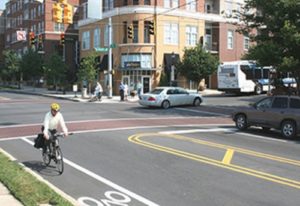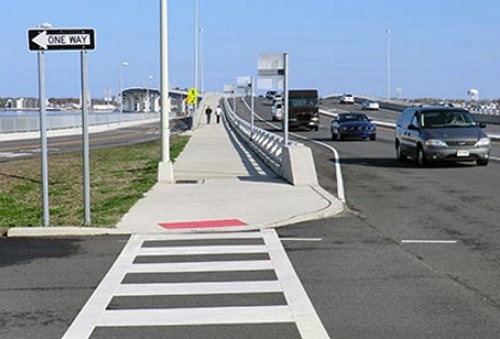The COVID-19 pandemic “locked in” many places across the country in late March when a variety of local and state governments issued stay-at-home orders – many of which still remain in place to help quell the spread of the virus.
[Photo courtesy of New Jersey state government.]
Many local and state governments recognized outdoor recreational activities such as walking, bicycling, and running as “essential activities” if conducted in compliance with social distancing requirements. However, many people found they did not have safe access to areas to participate in those activities – especially as parks completely closed to the public in many areas.
As a result, state and local governments are witnessing an opportunity to increase the availability of safe active transportation space in their urban areas. Some of the measures include:
- Closing certain streets to motorized vehicles. In Oakland, the city closed nearly 10% of its streets.
- Expanding or creating new priority zones for cyclists and pedestrians, creating “shared spaces.”
- Creating temporary or “pop-up” bike and pedestrian lanes through low-cost interventions (signage, traffic cones, and concrete barriers).
- Providing equipment and finance e.g. bike commuter benefits, shower facilities at workplaces, grants to local governments that want to implement slow street initiatives.
More than 200 cities around the world have taken some sort of action to expand pedestrian and bicycle access during the pandemic, according to data collected by researcher Tabitha Combs at the University of North Carolina’s Department of City and Regional Planning. Her research data set is part of a larger project collecting responses globally and includes the Walk/Bike/Social Distancing dataset, COVID19 Livable Streets Response Strategies, and COVID Mobility Works.

The Oakland Slow Streets Program is one example of these types of actions. The City of Oakland Slow Streets Program supports “safe physical activity” by creating more space for physical distancing for all city residents by declaring several local roads as “slow streets.”
“Slow streets” are closed to through traffic so that people can more comfortably use low-traffic areas for physically-distant walking, wheelchair rolling, jogging, and biking all across the city. To that end, the Slow Streets: Essential Places program in Oakland extends on the original program and provides intersection improvements to support residents’ safe access to essential services such as grocery stores, food distribution sites and COVID-19 test sites.
The Massachusetts Department of Transportation is also making strides in implementing a similar idea via a Shared Streets and Spaces grant program.
The agency partnered with the Barr Foundation to provide technical assistance and support to cities and towns interested in rapidly transforming their streets to facilitate responsible public health practices. The program resulting from that program includes providing funding for more outdoor seating and recreation space for businesses, as well as safe spaces and streets blocked off for pedestrian and bicycle traffic. As of early August, the program has given out a total of $3.8 million to fund projects in 48 municipalities across Massachusetts.
Alongside of state and local “slow street” encouragement programs are efforts to expand “green street” initiatives as well – largely in terms of altering street designs to better manage storm water runoff.
In the past, storm water often flowed over the urban surface areas, collecting pollutants and other trash, until discharged untreated into creeks, rivers, lakes, and eventually oceans. Today, storm water regulations require better management of such pollutants – and one such solution involves the construction of “greener” transportation infrastructure.
For example, design methods for green streets or living streets incorporate natural components such as grassy swales, detention basins, and tree wells to manage pollutants from street runoff – methods that promote storm water capture, water conservation, and improved groundwater supplies through infiltration. Green streets also include more trees and shade, which helps improve air quality and reduce urban temperatures.
More state and local governments are recognizing the importance of green infrastructure thinking and are developing tools for transportation planners and designers.
For example, the San Diego County Green Streets technical guidance document – developed by a contract with consulting firm WSP USA in 2018 – provides directives on green designs for new streets as well as outlines for taking into account when retrofitting existing paved roads to be “greener” and manage storm water runoff better.
Many other states and organizations are seeing the positive impacts of including green and living streets in their planning processes and are developing guidelines for their transportation planners.
The District Department of Transportation, for one, established a long-range plan in 2013 to make Washington, D.C., the “greenest city in the nation.” The plan calls for increasing green infrastructure in the public right-of-way and taking actions to improve the health of the city’s waterways.
“DDOT is installing Green Infrastructure or GI as part of construction projects and in retrofit projects to reduce storm water runoff in more areas of the city,” the agency noted. “Green Street and Green Alley projects utilize GI techniques and may be constructed where watershed and infrastructure improvements are prioritized.”
The New Jersey Department of Transportation adopted a similar long-range plan in July 2019 as a “one-stop resource” for New Jersey municipalities, counties, agencies, and organizations pursuing green street strategies.
According to the agency, “green street” design elements complement efforts to create more active transportation-friendly environments by:
- Creating an inviting and comfortable walking and bicycling environment by incorporating green infrastructure elements – such as street trees and rain gardens – that provide shade and remove pollutants from the air.
- Minimizing flooding along streets and sidewalks that interferes with and discourages walking and bicycling.
- Achieving efficiencies and cost savings when improvements are designed and constructed concurrently.
- Aiding in pedestrian safety by using green infrastructure installations to slow down traffic.

